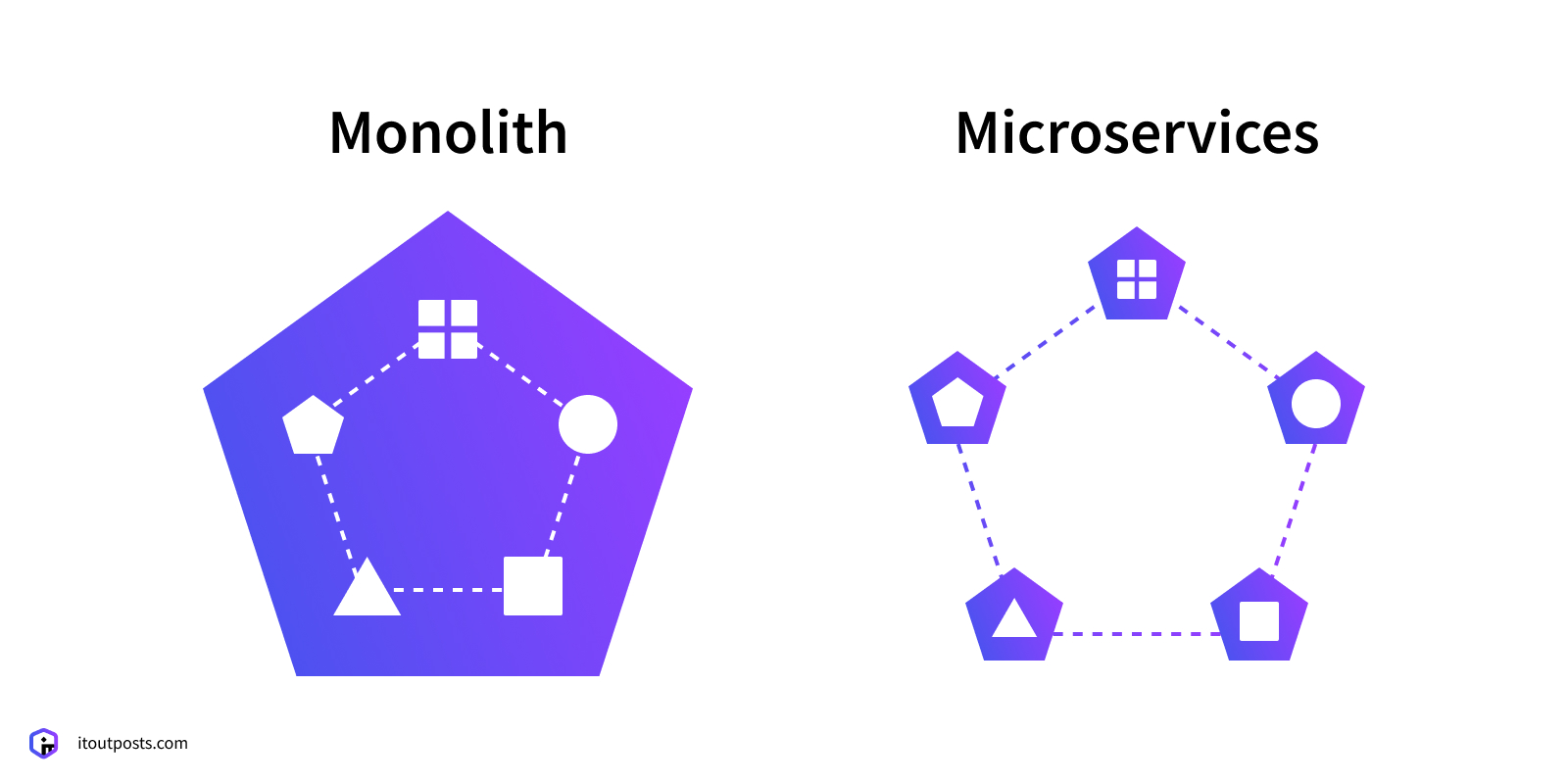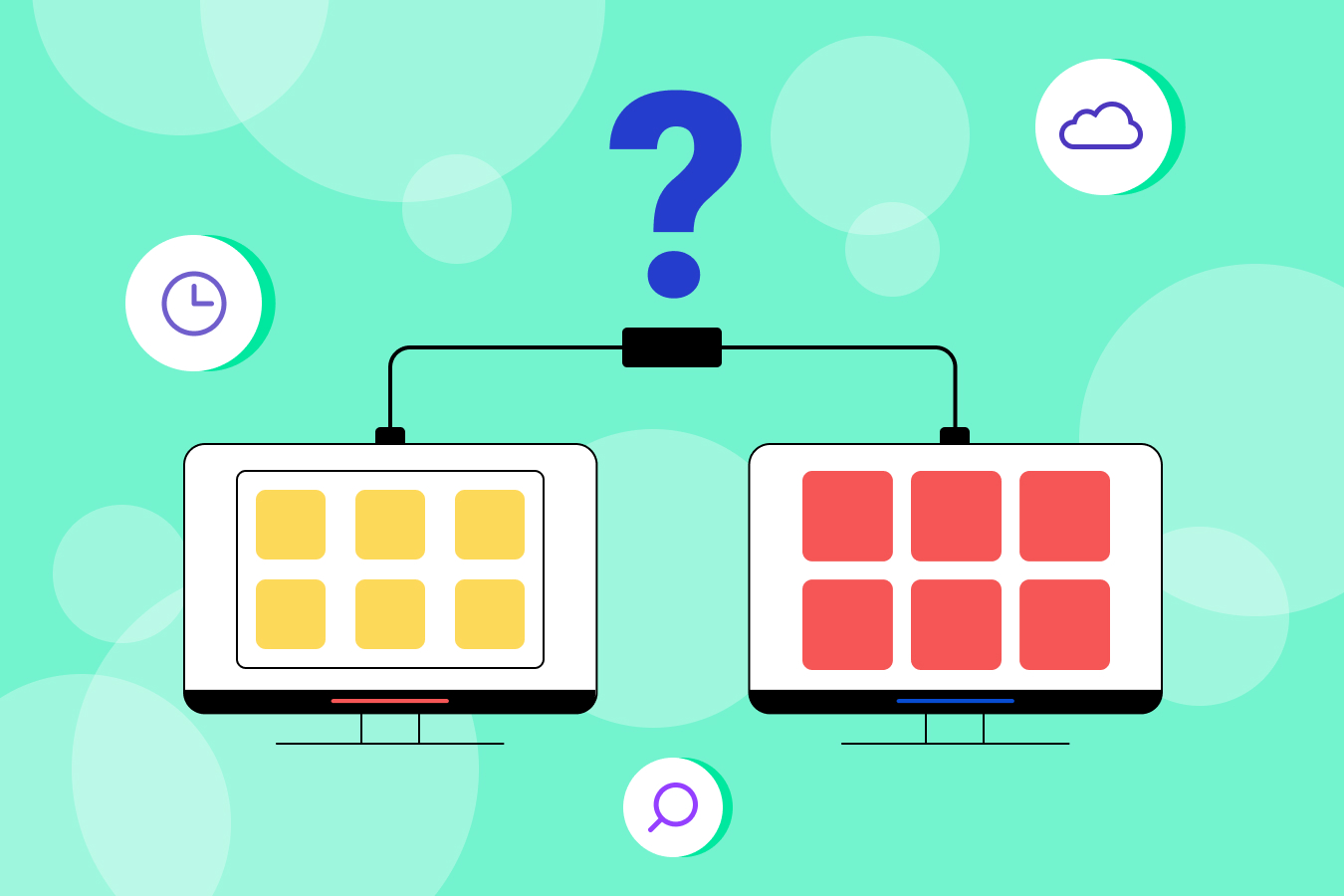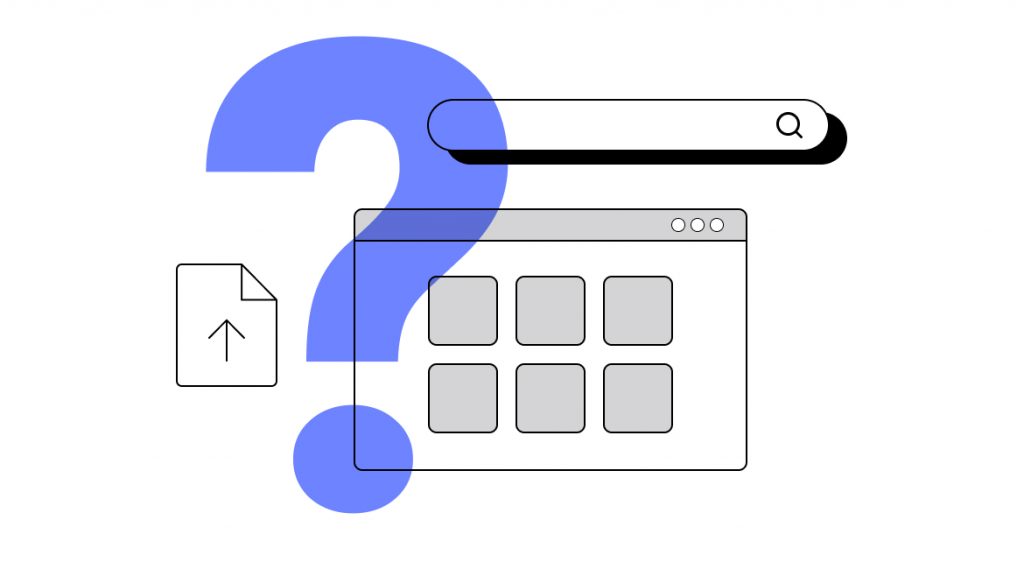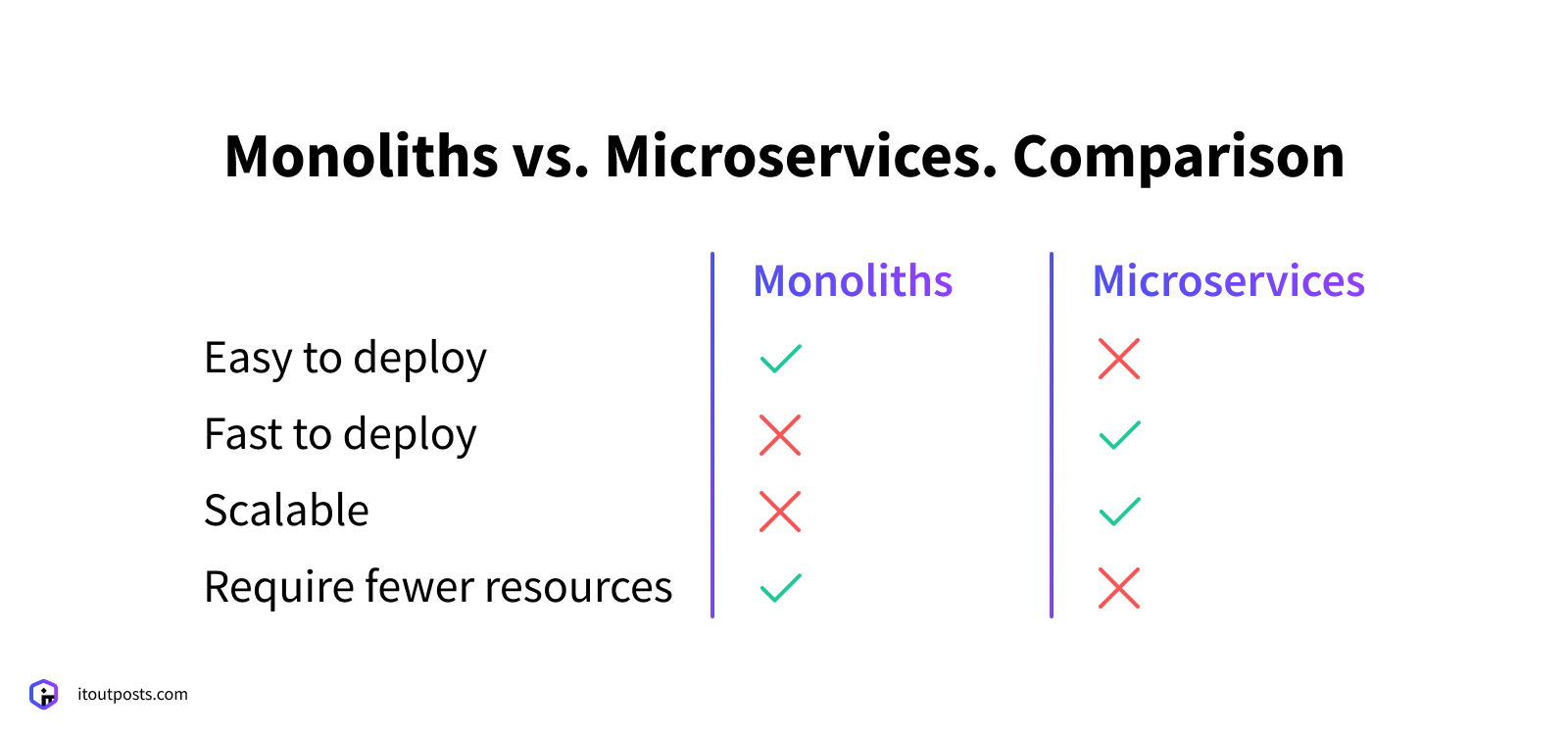Contents
In recent times, microservices have become a global trend. There are several advantages offered by the microservices, such as better scalability, flexibility, agility, and more. The shift from a monolithic architecture to microservices (Google, Amazon, Netflix microservices architecture) was implemented by several tech leaders. The following example is considered by many businesses to choose the most effective way to grow.
Monolithic applications are the default approach for developing software. Despite this trend, monolithic applications are declining in popularity since they are notoriously difficult to build because of multiple problems such as handling a huge codebase, implementing new technology, scaling, and deploying. Thus, at some moment, you may need to start looking for application modernization services.

Should the monolithic approach be abandoned for modern times? Are there any advantages to switching from a monolithic application to one that is composed of microservices? What are the business benefits of developing a microservices application?
Here, we’ll consider a comparison of monolith vs microservices, point out the advantages and disadvantages of both approaches, and decide which software architecture approach is right for your business.
Read also: Microservices Decomposition Strategy in 2024
Monoliths vs Microservices Advantages and Disadvantages Overview
Large corporations have increasingly shifted their use of monoliths to microservices, as mentioned above. However, monolithic architecture does not always have disadvantages. Here are the fundamental differences between microservices architecture vs monolithic architecture.
Strengths and weaknesses of Monoliths
Monoliths have the following advantages:
- Monoliths are easier for development. Monoliths have a lower level of complexity, so they are faster to develop. Apart from that, it is possible to start with a basic application and then add features as it develops.
- You can easily control monoliths. In part, this is due to a lower number of cross-cutting issues, such as logging or error detection. Having all of these cross-cutting concerns in one place allows them to be handled more easily.
- Testing monoliths is easy. Monolithic applications can be easily run and tested over and over again because they are composed of only one body.
Monoliths have the following cons:
- It is hard to comprehend monoliths. Scaling an application and adding more functions might seem like a good idea at first, but later it will become more complex to manage.
- The combination of monoliths and new technology is difficult. Monolithic architecture is a single unit, so introducing new technology will require rewriting the entire application.
- The nature of monoliths makes it difficult to change them. When you start making changes to a complex system, your app’s chances of going down increase. It may also take time for the development to be completed.
Monolithic applications can be hard to maintain, especially if they are poorly designed. Monolithic systems are known to have tightly coupled processes, therefore even a small change can cause several issues related to the codebase. A single change can result in an entire program not functioning.
Strengths and weaknesses of Microservice Architecture

Let’s review microservices pros and cons.
Microservice architecture has the following pros:
- Independent components. It is possible to deploy and update all the services independently, thus giving you more flexibility. Secondly, a bug in one microservice does not impact the entire application but only affects that service. In terms of monolithic vs microservices architecture, microservices applications are much easier to develop than monolithic applications.
- It is easier to understand. A microservice application can be easily understood and managed because it is broken down into smaller, simpler components. You focus only on a particular service that is related to your business goals.
- Scalability is improved. Among the advantages of the microservices approach is the ability to scale each element independently. This is more cost- and time-efficient than scaling monolithic applications, even when it is not needed. As you get more customers, your monolith will face more and more problems in terms of scalability. Therefore, many companies are forced to rebuild their monolithic architecture.
- Technology can be chosen with flexibility. Technology isn’t a limiting factor for engineering teams. Microservices can be built with a variety of technologies and frameworks.
- High levels of agility. When there is a fault in a microservice application, it affects only that specific service and not the entire application. Consequently, all changes and experiments are accomplished with fewer errors and reduced risks.
Microservices have the following cons:
- Complexity is added. In a microservices architecture, the modules and databases need to be connected within and between each other. Additionally, independent services within such an application must be deployed independently.
- Distribution of the system. In a microservices architecture, multiple databases and modules interact, so all connections must be managed carefully.
- Cross-cutting concerns. There are several cross-cutting concerns to be considered when designing a microservices application. Among them are configuration externalization, metrics, logging, and health checks.
- Testing. It is very difficult to test a microservices-based solution since there are so many independently deployable components.

Hire a team of DevOps engineers with IT Outposts
Contact UsMicroservices vs. Monolithic Architecture: What’s The Difference?

We will analyze the complexity, reliability, latency, and scalability of monolithic architecture vs microservices to gain a better understanding of the differences.
Scalability
It is not only microservices that are scalable. A monolith can also be scaled. However, monolithic applications can be scaled in one dimension and by running multiple copies. With an increasing data volume, you will not be able to scale it up. A microservices application can therefore scale with fewer resources, which is an absolute advantage of microservices.
Complexity
In our previous discussion of monolithic architectures, we mentioned their low complexity. Microservices involve a plethora of source codes, frameworks, and technologies depending on how complex your application is. Multiple servers can host the services, which communicate via APIs between them.
The architecture of this type requires a different development methodology and requires a higher level of coordination, skillset, and understanding of the overall architecture.
Latency
An entity’s latency refers to the time that elapses between the stimulation and response that occurs after a certain physical change occurs. Microservices are mostly concerned with that. A microservice sends or receives byte data over the network when communicating with another service. Bytes become electrical signals, which become bytes again.
Monoliths, on the other hand, do not experience network latency since all services are located within the same workflow. Due to these reasons, microservices perform slower than monoliths.
Reliability
A monolith consists of only one server where all calls and processes occur. In other words, if the network fails, the entire application will go down. In contrast, network calls from microservices are 99.9% reliable. When one of the microservices fails, error isolation, another microservices feature, allows you to maintain the application.
Monolithic Architecture: When to Use It?
Monolithic approaches are sometimes time-tested strategies:
- A small app is on your to-do list.
- Your company does not plan to grow. This situation does not call for the design and management of a complex system.
- You’re in the ideation phase. Your product is likely to grow over time if you are at the first stage of SDLC. Fast iteration is possible with a monolithic architecture.
- An MVP is what you are building. Monolithic apps are the quickest way to gather feedback from first users at this stage.
When Should You Choose Microservices?
Following a significant rise in customer demand, many companies moved to microservice architecture. Among them are Amazon, PayPal, Spotify, and many more.
- Your goal is to build a large-scale solution.
- Since microservice architecture requires careful planning, you have plenty of time to spare.
- As your project grows, scalability becomes more critical.
- It’s important to use different languages to write the backend and the frontend, such as C++ for the backend and Rails for the front end.
- There should be different independent teams working on the different functions of your solution.
Read also: DevOps Adoption: Top 6 Essential Challenges
What’s the Best Choice for Business?
If you want to create a complicated application, in addition to having the necessary knowledge you should be prepared for many kinds of expenses. Alternatively, monolithic architectures work well for lightweight development.

Different types of architecture are favored by different people. Some believe you should build your first application as a monolith and then switch over to microservices as you go. In contrast, if your goal is to develop a microservices application, there is no need to start with monoliths.
To determine the most appropriate architecture, you must consider the following factors:
- Type of the applications you are planning to develop
- Projects timeline
- Finances
- Experience with applications
Conclusion
Monoliths remain the base of applications, despite microservice architectures being touted as the future. Choosing the type that suits best for your company is up to you. For assistance in switching from monolith to microservices, please contact us. With an arsenal of proven tools and technologies, IT Outposts helps you make your business successful.

I am an IT professional with over 10 years of experience. My career trajectory is closely tied to strategic business development, sales expansion, and the structuring of marketing strategies.
Throughout my journey, I have successfully executed and applied numerous strategic approaches that have driven business growth and fortified competitive positions. An integral part of my experience lies in effective business process management, which, in turn, facilitated the adept coordination of cross-functional teams and the attainment of remarkable outcomes.
I take pride in my contributions to the IT sector’s advancement and look forward to exchanging experiences and ideas with professionals who share my passion for innovation and success.